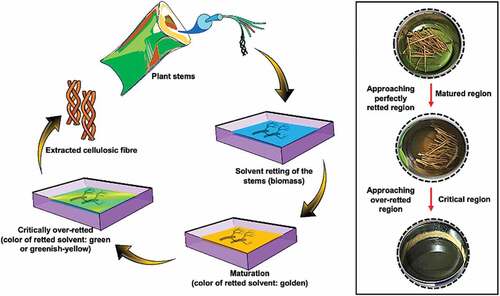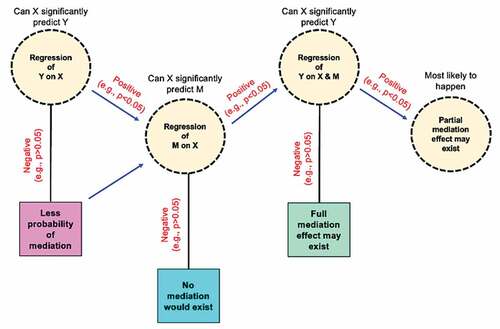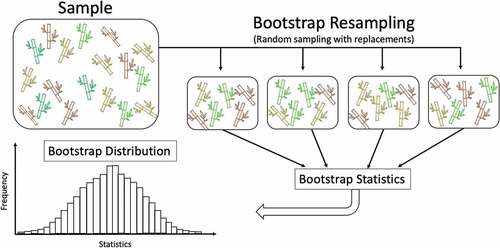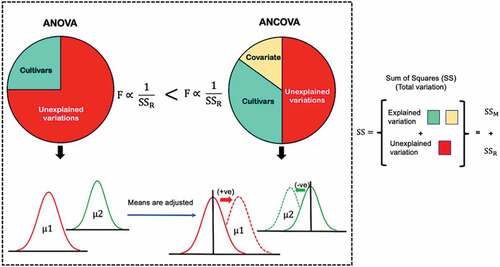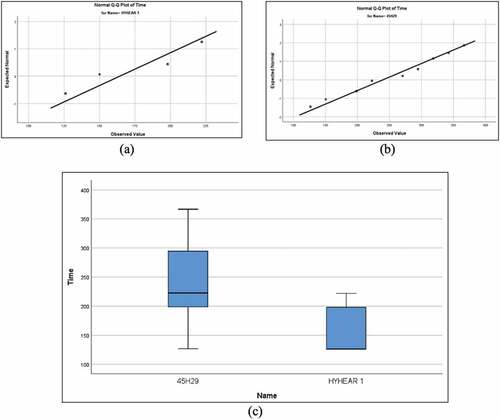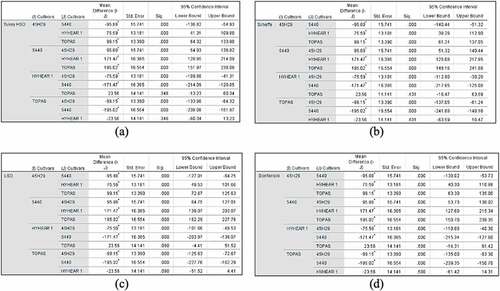 ?Mathematical formulae have been encoded as MathML and are displayed in this HTML version using MathJax in order to improve their display. Uncheck the box to turn MathJax off. This feature requires Javascript. Click on a formula to zoom.
?Mathematical formulae have been encoded as MathML and are displayed in this HTML version using MathJax in order to improve their display. Uncheck the box to turn MathJax off. This feature requires Javascript. Click on a formula to zoom.ABSTRACT
The study aims in applying two statistical tools to analyze the retting behavior of plant stems for extracting bast fibers for industrial applications. At first, a mediation model is employed to investigate the first hypothesis of this work that involves studying the color response of the retted solvent as a function of retting time on the responsible variable, fiber yield (%). Statistically, there is a significant indirect effect of retting time on fiber yield (%) through retting trait (β = −0.0142, 95% C.I. [−0.0274, −0.0011]) – a statistical inference bolstered by the Sobel test result, confirming the mediation effect (p-value = 0.0329 < 0.05; z-score = −2.1334; bootstrapping of 5000 resamples). Next, the second hypothesis of the current work involves analyzing the impact of stem form-factors on their retting time using the statistical tool, ANCOVA. The partial- η2 indicates that cultivar treatment accounts for 30% variance of the retting time while controlling for the effects of two covariates – diameter and length of the stems, in this case. By controlling the Type-I error, Bonferroni and similar post-hoc tests also confirm the statistical significance of cultivar categories pertaining to their mean retting time. Future work could focus on these underlying hypotheses and study the impact of microorganisms, environmental factors, and cultivar treatment variables on the retting time to optimize the overall fiber yield and production process.
摘要
本研究旨在应用两种统计工具分析用于提取工业用韧皮纤维的植物茎的脱胶行为. 首先,采用中介模型来研究这项工作的第一个假设,该假设涉及研究脱胶溶剂的颜色响应,作为脱胶时间对相关变量纤维产量(%)的函数. 统计上,脱胶时间通过脱胶性状(β=-0.0142,95%C.I.-0.0274,-0.0011)对纤维产量(%)有显著的间接影响,这是一个由Sobel检验结果支持的统计推断,证实了中介效应(p值=0.0329<0.05;z分数=-2.1334;自举5000个重取样). 接下来,当前工作的第二个假设涉及使用统计工具ANCOVA分析茎形因素对其脱胶时间的影响. 部分η2表明,在这种情况下,品种处理占脱胶时间的30%方差,同时控制两个协变量的影响——茎的直径和长度. 通过控制I型误差,Bonferroni和类似的事后检验也证实了与平均脱胶时间相关的品种类别的统计显著性. 未来的工作可以集中于这些基本假设,并研究微生物、环境因素和品种处理变量对脱胶时间的影响,以优化整体纤维产量和生产过程.
Introduction
Plants are a great source of engineered fibers and their applications in nonwoven and composites have already proven effective for industries like geotextiles, aerospace, automotive, furniture, smart materials, and lightweight materials Shadhin and Shuvo Citation2019; Shuvo et al. Citation2019; Shuvo Citation2020a; Citation2020b; Shuvo et al. Citation2021; Shuvo, Shah, and Dagdeviren Citation2022. Canola (Brassica napus L.) – a new generation industrial cellulosic bast fiber, for example, is extracted from the plant stems (biomass) by solvent retting technique (Shuvo Citation2021; Shuvo and DuCharme Citation2021; Shuvo et al. Citation2019). As this new generation cellulosic fiber has been recently discovered in Canada, a study on their retting behavior is, thus, critical since it determines the ultimate fiber production volume and the fiber yield (%) (Sevenhuysen and Rahman Citation2016; Shuvo et al. Citation2018). Furthermore, the bast fiber retting process also influences their mechanical strength in nonwoven configurations or polymer-reinforced composites (Lee et al. Citation2020). Hence, retting plays a critical role in synthesizing the cellulosic bast fibers from the biomass. The synthesized fiber yield (%) of these bast fibers could be calculated from the ratio of mass of the extracted fiber to the mass of the retted stem at oven-dry weight (Khan Citation2016; Shuvo Citation2021; Shuvo et al. Citation2019).
Once the stems are properly retted, the fibers could be easily extracted mechanically from the stem exterior. However, no prior research work has been conducted in identifying the significance of determining the endpoint of the retting period for these canola plant stems. From a scientific point-of-view, retting period cannot run for an infinite period of time, and thus, a solution must be introduced to assess the endpoint of the retting period. However, before an endpoint could be determined, it is essential to deduce whether the retting time and its different phases have any kind of influence over the fiber production (fiber yield) process whatsoever. It is also imperative to investigate whether the dimension of the plant stems have any impact on the retting time as it can save time for the operators from handpicking the specimens based on their shapes or sizes for industrial production. To study these hypotheses, the current work employed two statistical models – Mediation and ANCOVA (Analysis of Covariance).
Hypothesis development for impact of retting time on fiber yield (%)
Generally, a typical solvent retting process of canola biomass involves treating the canola stems with H2O solvent for weeks in a container (Shuvo et al. Citation2019). As the retting process gradually takes place, the color of the solvent evolves from a transparent color to a golden color, and then, from golden to a green (or greenish yellow) color as what we have identified in the current work (). As seen, the color response (mediator) of the retted solvent is clearly changing with the progressing retting time (independent variable), and thereby, might have an effect on the fiber extraction/yield (dependent variable) as fiber extraction is executed by the industry operators at different arbitrary points of the retting time. Hence, we hypothesized that there could be an effect of the retting time on the fiber yield (%), mediated through the retting trait (color of the retted H2O solvent: golden and green). As the solvent retting process of these organic biomass (plant stems) is a biotic process, involving microorganisms like bacteria or fungi (Fedorak Citation2005), we hypothesized that the best time to stop the retting time is before the fiber starts degrading. Our observation showed that when the retting color of the solvent approaches from golden (termed as maturation region) to greenish yellow or green (termed as critical region), it starts creating a bad odor and fiber starts breaking down from the stem exterior and degrade into the retted solvent liquor. Hence, the extraction of fibers from the plant stems during the maturation region could maximize the overall fiber production volume by optimizing the fiber yield (%). This is the central route of the mediation model – retting trait (maturation region: golden color; critical region: greenish yellow or green color) mediates the effect of retting time on fiber yield (%) or production. We posit the following hypothesis, H1, to refer this relationship:
Hypothesis, H1: Retting trait mediates the effect of retting time on the fiber yield (%), where the yield (%) reduces if retting time is extended beyond the maturation point and vice versa. Fiber yield (%) could be maximized by extracting the fibers from the stem at the maturation region when color of the retted solvent becomes golden; however, beyond the maturation region lies the critical region, where color of the retted solvent is greenish-yellow (or green) and fiber slowly starts to degrade, causing a decline in the fiber yield (%) with any increase of the retting time units.
Further, we also hypothesized a relation might exist between the dimension (length and diameters) of the biomass stems and their corresponding retting response, which has been discussed in the following Section 1.2.
Hypothesis development for impact of stem dimension on their retting time
Earlier research works have worked on the retting behavior of different plant cultivars (Khan Citation2016; Shuvo Citation2019). Few researchers also demonstrated the impact of dew-retting (Habeck Citation2017) and enzyme retting (Shuvo Citation2021; Tahir et al. Citation2011). Mechanical decortication of flax and hemp have been also been studied (Munder, Ch., and Hempel Citation2004). However, there exists minimal efforts in studying the impact of the dimensional aspects of plant stems on their retting behavior. Therefore, the current study employed a ANCOVA model to investigate the influence of stem length and diameter on their retting time across different levels of canola cultivars, HYHEAR 1 and 45H29, for example.
ANCOVA is a blend of ANOVA and regression; it extracts additional information by considering one independent treatment variable (TV) (like different categories of canola cultivars) at a time, without the influence of others. Consequently, ANCOVA treats the datasets and demonstrates the main and interaction effects of categorical TVs on a continuous dependent variable (DV) (like retting time), by controlling the influence of any continuous independent variables of interest, known as covariates (CVs) (like stem diameter and length), which could co-vary with the TVs. To the best of our knowledge, this is the first study in investigating the retting time of plant stems pertaining to their dimensions (CVs) and cultivar categories (TVs) using the ANCOVA model. If the CVs are found to have any significant effect (p <.05) on the DV, then it is possible to control for their influence by including them in the regression model. We posit the following hypothesis, H2, to refer this relationship:
Hypothesis, H2: Retting time of plant stems doesn’t vary only based on their cultivar types (treatment variable) but also based on the plant dimensions; for example, stem length and diameter – the two covariates.
Hence, in this current work, two different statistical model was employed for studying the canola plant stems – firstly, to investigate the impact of their retting time on optimizing the fiber yield (%), mediated by the retting traits, using the Mediation model; and secondly, to investigate the effect of two covariates (stem length and diameter) on their retting time variance. Additionally, the ANCOVA model will also explain the total explained variance of the cultivar categories (HYHEAR 1 and 45H29) on retting time, while controlling the covariates. As canola is a new generation cellulosic fiber (Shuvo et al. Citation2018), the observed hypotheses of this experimental study will ultimately facilitate in building a new knowledge for the cellulosic and textile fiber industries worldwide. Consequently, the findings of this statistical study will save time for the operators and will make the overall fiber production process more efficient at the industry level.
Experimental
Materials
Full-grown canola plant stems were cultivated and harvested inside a greenhouse (temperature: high 25°C, low 22°C, relative humidity 40–50%, light cycle: 16 hours light, 8 hours dark) at the Crop Technology Center of the University of Manitoba. Following the harvesting, the plant stems were retted inside a retting chamber with H2O solvent medium at the Textile Laboratory in the Department of Biosystems Engineering at the University of Manitoba. ASTM D2495-07 standard was employed to oven-dry the unretted stems and retted fibers for calculating the fiber yield (%) (ASTM International Citation2019). For the Mediation Model, four different canola cultivars were solvent-retted, which were HYHEAR 1, Topas, 5440, and 45H29. However, for the ANCOVA model, studies were only constrained between the HYHEAR 1 and 45H29 cultivars, as only this pair comprised relatively larger data set.
Methods
Mediation model
The basic theory of a mediation model could be summarized through . As shown in the illustration, the idea is to investigate three sets of regression model: (i) Y (outcome/dependent variable like fiber yield: DV) on X (independent variable like retting time: IV) in isolation; (ii) M (mediator like retting traits) on X; and (iii) Y on X plus M (Kim Citation2016). The idea is to observe whether the impact of X on Y completely disappears, or its magnitude is weakened by including the M in the regression model. If the magnitude of the effect is affected from the inclusion factor of M, then a full or partial mediation effect may exist.
For the Mediation model, the current work calculated the fiber yield (using EquationEquation 1)(1)
(1) of canola stem specimens at two arbitrary retting points: (i) right at the moment when the solvent color becomes golden (in the maturation region) and (ii) when it becomes greenish-yellow or green (in the critical region). After stopping the retting and measuring the fiber yield (%) of 50% of the stem specimens (N = 12) at maturation region, rest of the 50% specimens (N = 12) were left to ret in the solvent until they reached the critical retting region. The retting time and fiber yield of the retted stem are shown in . Hence, the mediator to optimize the fiber yield (%) by optimizing the solvent retting time in this current work is the retting trait (maturation region and critical region). To conduct the mediation model, SPSS PROCESS Model 4 was employed with a bootstrapping () of 5000 resamples (Hayes Citation2017). In the mediation model, a Likert scale of 1–10 was employed to characterize the retting traits, where a higher trait score indicates higher visibility of golden color of the retted solvent (referring to the optimum maturation point) and a lower trait score indicates the greenish color with a bad odor of the retted solvent (referring to the high end of critical regions).
Table 1. Retting time and fiber yield of different plant stems (for the mediation model).
ANCOVA model
The fundamental concept of ANCOVA lies in increasing the statistical power by controlling one or more independent variables termed as the covariates and reducing the proportion of unexplained variance – an analytical study that differentiates ANCOVA from ANOVA (). As the unexplained variance is reduced, the statistical power increases, i.e., the increment of F values (following EquationEquation 2)(2)
(2) as shown in the illustration. Consequently, ANCOVA adjusts the mean values of the variables, allowing Post-Hoc tests (like Fisher’s LSD, Scheffe, Tukey or Bonferroni procedure) to compare and confirm where the differences occurred between the pairs of groups (experimental/treatment variable like cultivars in current work).
In the current experiment, for the ANCOVA model, stems of four different canola cultivar plants were chosen, which were HYHEAR 1, Topas, 5440, and 45H29, and their dimensions and retting time were recorded. The ANCOVA study was modeled based on the single pair of HYHEAR 1 (N = 37) and 45H29 (N = 47) (), and the associated data entry is recorded in the SPSS for ANCOVA model as well. The associated dataset for the Topas and 5440 cultivars are provided in the supplemental file (Appendix I).
Table 2. (a) Retting time and stem dimension of HYHEAR 1 plant stems (for ANCOVA model). (b) Retting time and stem dimension of 45H29 plant stems (for ANCOVA model).
Data analysis
To conduct the Mediation model, SPSS PROCESS Model 4 was employed using the IBM SPSS Statistics software (version 26). The studies of normality, ANOVA, and ANCOVA was also performed using the SPSS platform.
Results and discussion
Observations from the mediation model
After analyzing the data using SPSS, the following model () has been illustrated for the biomass retting time as a predictor of optimizing the fiber yield, mediated by the retting trait commitment. This linear model of stem retting trait (or the color of the retted water) could be predicted from their solvent retting time (i.e., the path a in ) and the linear relationship is significant as t = −7.0590, p = .000, 95% CI [−0.0352, −0.0192] ().
Figure 6. Model of biomass (plant stems) retting time as a predictor of optimizing the fiber yield, mediated by retting trait commitment. The confidence interval for the indirect effect is a BCa bootstrapped CI based on 5000 samples.
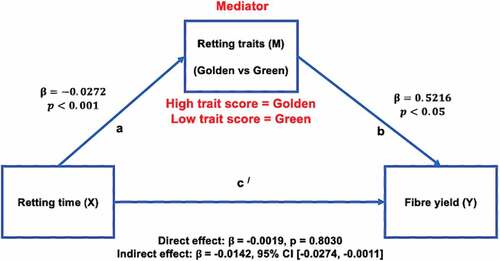
Also, the R2 value signifies that 66.50% of the variance of stem retting trait is explained by their retting time (). Interestingly, the negative value of the coefficient ( = −0.027) confirms that as retting time increases beyond the maturation point, the trait score is reduced (i.e., color of the retted water no longer stays golden and gradually becomes greenish-yellow or green), indicating the breach of the optimum threshold limit of maturation point, and vice-versa.
In the dependent-variable model, retting time significantly explained the variance in fiber yield (%) (t =2.2603, p =.0345 < 0.05), but the main effect (or direct effect, which is the path c-prime) of retting time was not significant (t =−0.2527, p =.8030 > 0.05) (). It indicates that at a higher trait score (when the solvent color is golden), the fiber yield (%) is also maximized, and vice-versa. Also, the regression model demonstrated that the impact of retting time on yield completely disappeared when the retting trait is added into the regression model – the confirmation of the statistical inference of the mediation model.
Statistically, there was a significant effect of retting time on fiber yield (%) through retting trait ( = −0.0142, 95% C.I. [−0.0274, −0.0011] as deduced by the SPSS PROCESS Model 4 (). The true value of this beta falls between −0.0274 and −0.0011 at 95% confidence interval (C.I.). Since the true values of parameters are contained within the 95% C.I. and a value of 0 for the beta indicates no effect whatsoever, we can conclude that retting trait truly mediate the relationship between retting time and fiber yield (%) as the resultant C.I. doesn’t contain 0 within the closed set {-0.271, −0.0029). In simple words, the mediation effect has been proven, and thus, the first hypothesis (H1) of this study.
The final part of the PROCESS Model 4 exhibits the Sobel test result to bolster the current hypothesis (H1). Again, the size of indirect effect, = −0.0142 (), from the Sobel test confirms that there is a significant mediation effect as the p value and associated z-score are 0.0329 and −2.1334, respectively. Hence, there exists a significant indirect effect of retting trait on maximizing the fiber yield (%) through optimizing the retting time. The summary of the experimented mediation model is provided in the following .
Table 3. Summary of the statistical mediation model.
From the summary , it is observed that there is a total effect of retting time (X) on fiber yield (Y) which meet the first assumption of the mediation model. However, when the mediation factor, i.e., the retting trait, is included in the model the direct effect of X on Y has been reduced, which agrees with the assumption of the mediation model.
Observations from the ANCOVA model
Comparison between ANOVA and ANCOVA results
Although the value of p =.000 < 0.05 has not changed for both the ANOVA and ANCOVA models, the unexplained variation (error) has been slightly reduced from 277818 to 276895, and thereby, the resultant assumptions from the ANCOVA model has been briefly reported in the following segments for any future comparative studies. Additionally, the value in the ANCOVA model indicates that cultivar treatment (TV) accounts for 30% variance of the retting time (DV) by controlling the covariates – diameter and length of the stems; while diameter accounts for 0% of the variance and length 0.3%. Consequently, stem length or diameter has no significant impact (as p >.05) on the retting behavior of the stems. These results reject the second hypothesis of this experiment – H2. However, the analysis also indicates that the intrinsic chemical proportionality or the ambient conditions like temperature or relative humidity might have played the pivotal role in the retting behavior. Therefore, more research work is recommended in this new field for canola fibers.
Resultant assumptions from ANCOVA model
First assumption of ANCOVA- test of Independence
One of the prime assumptions of any ANCOVA model indicates that the covariates (CV: stem diameter and length) and treatment variables (TV: cultivar levels) must be independent to avoid any confounding effect (Field Citation2017). Durbin Watson (DW) test was conducted, and the resultant value was found 0.055.
Second assumption of ANCOVA- test of normality
Although normality doesn’t greatly affect the ANCOVA test, the current work also tested the normality. From the Q-Q plot, it can be observed that the deviation between expected and observed value is very low, exhibiting a fairly ideal dataset for this current research work ()). Again, the ANCOVA test is robust to the violation of normality. In addition, from the boxplot-whisker diagram, it can be also seen that there lie no data points outside the whiskers, i.e., no outlier exists ()). Although the value of Kolmogorov-Smirnov and Shapiro-Wilk test result was found significant ()), it is not a concern as ANCOVA is robust to the violation of normality.
Third assumption of ANCOVA- test of homogeneity of regression slopes
The assumption on test of homogeneity refers that the regression slopes between covariate (CV) and outcome (DV) must be homogeneous or same (either +ve or -ve) for all TVs, which means there must be a linearity between CV and DV for each level of the TV (cultivar type) (Andy Field Citation2017). Otherwise, controlling the CVs does not make any valid mathematical argument, and consequently, the ANCOVA model will become inaccurate. Furthermore, the interaction between length and cultivar level is not significant (p =.083 > 0.05) without any contrast for diameter (p =.978 > 0.05) as well. Although, Levene’s test result indicates a value of p < .001, ANCOVA analysis is very robust to the violation of homogeneity of variance (Field Citation2013).
Post-hoc analysis to investigate variation among the four cultivars
As cultivar categories account for a larger proportion of the retting behavior of plants, the current work conducted multiple Post-hoc tests to investigate the variation among the pairs of the four cultivars, both liberal (e.g., Fisher’s LSD) and conservative (e.g., Bonferroni’s, Tukey’s, and Scheffe’s) tests as their influence over controlling the Type I error varies with their statistical power (). The observations confirm that a statistically significant variation exists for the retting time among every pair of the cultivars except between HYHEAR 1 and Topas (p >.05).
Limitations and future work
The study has a limitation as it is modeled on few cultivars only, and the observed results may not necessarily represent the whole population mean. Future work could focus on these underlying hypotheses and study the impact of different cultivar treatments on the retting time. Also, it is recommended to study the behavior of different covariates like microorganisms or ambient factors like retting temperature to optimize the overall fiber yield and production volume.
Conclusion
As world is moving toward greener initiatives, so are the fiber and textile engineering industries. Since canola is a new generation organic cellulosic fiber – as it was discovered 5 years back – a knowledge domain must be constructed on this category of fiber for the materials and textile industries. The current work took an effort to characterize the retting behavior of canola plant stems (biomass) – source of synthesizing this cellulosic material. As canola is easily biodegradable, much attention must be given to its retting traits to optimize the fiber yield (%) and prevent unnecessary degradation in the retting media. Therefore, a statistical mediation model was employed to confirm when to stop the retting treatment before the fiber would start to degrade in the solvent. As soon as the hue of the retted solvent turns golden, it is recommended to check possibility of mechanical extraction of fiber from the stem exterior. Before the hue turns green (greenish yellow), it is highly recommended to unload the canola stems from the retting bath and finalize the fiber extraction process. Otherwise, there is a likelihood of significant loss in the fiber production process using the H2O solvent retting technique. Further, ANCOVA was applied to report the effect size of stem dimensions in explaining the variance over the retting time. No significant influence was confirmed using the ANCOVA model; however, the study demonstrated how covariates could be controlled and included in the regression model if necessary. As such, operators can save time during the biomass collection stages as they do not need to hand pick plant stems of any specific size or shape for solvent retting. Interestingly, the influence of cultivar type was marked significant, accounting for 30% of the variance of the retting time. As Post-hoc tests demonstrated, HYHEAR 1 could be alternatively used for Topas due to their similarity with the mean retting time; however, the statistical observation might or might not be inconclusive and more work needs to be done in this field for industrial implications. Future work could focus on the selection methodology of cultivars that could be attributed to optimize the retting time in order to maximize the fiber yield (%) to save time and cost of production.
Highlights
Demonstrating solvent retting dynamics to optimize fibre extraction of cellulosic fibres
Studying the color response of the retted solvent as a function of retting time
Investigating the effect of retting time on fibre yield through MEDIATION tool
Quantifying the impact of stem form-factors on their retting time using ANCOVA tool
Applying both categories of liberal (e.g., Fisher’s LSD) and conservative (e.g., Bonferroni’s, Tukey’s, and Scheffe’s) Post-hoc tests to examine significance with four different cultivars
Data availability materials
All data generated or analyzed during this study are included in this article.
Ethics approval and consent to participate
This research does not contain any studies on human participants or animals performed by the author.
Supplemental Material
Download MS Word (19.5 KB)Acknowledgments
The authors would like to thank Dr. Mashiur Rahman (Biosystems Engineering, University of Manitoba, Canada) for his valuable supervision on the natural fibre synthesis techniques. Also, the authors extend their gratitudeto the community of University of Manitoba, University of Alberta, MITACS Canada, and Media Lab, Massachusetts Institute of Technology (MIT), USA, for their continued support and constructive guidelines for the responsible conduct of scientific research studies.
Disclosure statement
No potential conflict of interest was reported by the author(s).
Supplementary material
Supplemental data for this article can be accessed online at https://doi.org/10.1080/15440478.2022.2091707
References
- ASTM International. 2019. ASTM D2495-07- standard test method for moisture in cotton by oven-drying. ASTM International, USA.
- Fedorak, P. M. 2005. Microbial processes in the degradation of fibers. In Biodegradable and sustainable fibres, ed. R. S. Blackborn, 1–35. UK: Woodhead Publishing Series in Textiles. doi:10.1533/9781845690991.1.
- Field, A. 2013. Discovering statistics using IBM SPSS statistics.introducing statistical methods. 4th ed. London:SAGE Publications, https://books.google.com/books?id=srb0a9fmMEoC.
- Field, A. 2017. Discovering statistics using IBM SPSS statistics. 5th ed. London: Sage Publications, Inc.
- Habeck, J.-C. 2017. Effect of dew retting and maceration on fibre properties of hemp and flax in manitoba. Manitoba Heritage Theses [5892]. University of Manitoba.
- Hayes, A. F. 2017. Introduction to mediation, moderation, and conditional process analysis, second edition: a regression-based approach. In Methodology in the social sciences. New York, USA: Guilford Publications. 75–216. https://books.google.ca/books?id=8ZM6DwAAQBAJ
- Khan, M. R. I. 2016. Evaluation of brassica fibre for textile and spinning properties. FGS - Electronic Theses and Practica [24968]. University of Mantioba.
- Kim, B. 2016. Introduction to mediation analysis. UVA Library StatLab. https://data.library.virginia.edu/introduction-to-mediation-analysis/.
- Lee, C. H., A. Khalina, S. H. Lee, and M. Liu. 2020. A comprehensive review on bast fibre retting process for optimal performance in fibre-reinforced polymer composites. Advances in Materials Science and Engineering July:1–27. doi:10.1155/2020/6074063.
- Munder, F. C., H. Hempel, and H. Hempel. 2004. Results of an advanced technology for decortication of hemp, flax and linseed. Molecular Crystals and Liquid Crystals 418 (1):165–79. doi:10.1080/15421400490479253.
- Sevenhuysen, G., and M. Rahman. 2016. Textile fibres and textiles from brassica plants. filed Sept. 18, 2014, and issued 2016. Patent WO2015039243 A1.
- Shadhin, M., and I. Iftekhar Shuvo. 2019. Biopolymer flax (Linum Usitatissimum L.) and its prospects in biodegradable composite fabrication- a short review. Journal of Textile Engineering & Fashion Technology 5:5. doi:10.15406/jteft.2019.05.00212.
- Shuvo, I. I., M. Rahman, R. Duncan, S. Ducharme, and L. Choo-Smith. 2018. A new generation of textile fibre from canola biomass and the impact of cultivar on fibre quality. In Integrating Design with Sustainable Technology, at The 91st Textile Institute World Conference (TIWC). Leeds, UK: Textile Institute.
- Shuvo, I. I. 2019. A smart textile fibre from biomass of brassica napus L. and the impact of cultivar on fibre quality. University of Manitoba.
- Shuvo, I. I., M. Shadhin, and M. Rahman. 2019. Aerospace composite structure: routing a thermoset composite fabrication model by prepeg lay-up medium to manufacture sandwich panels for aircraft. Research & Development in Material Science 12 (1). doi:10.31031/RDMS.2019.12.000780.
- Shuvo, I. I., M. Rahman, T. Vahora, J. Morrison, S. DuCharme, and L.-P. Choo-Smith. 2019. Producing light-weight bast fibers from canola biomass for technical textiles. Textile Research Journal 90 (11–12):1311–25. doi:10.1177/0040517519886636.
- Shuvo, I. I. 2020a. Fibre attributes and mapping the cultivar influence of different industrial cellulosic crops (cotton, hemp, flax, and canola) on textile properties. Bioresources and Bioprocessing 7 (1):51. doi:10.1186/s40643-020-00339-1.
- Shuvo, I. I. 2020b. Hollow canola-wood thermoset composites from concept to completion: Fabrication, performance, failure and reliability analysis. SN Applied Sciences 2 (12):2087. doi:10.1007/s42452-020-03931-4.
- Shuvo, I. I. 2021. A holistic decision-making approach for identifying influential parameters affecting sustainable production process of canola bast fibres and predicting end-use textile choice using principal component analysis (PCA). Heliyon 7 (2):e06235. doi:10.1016/j.heliyon.2021.e06235.
- Shuvo, I. I., and S. DuCharme. 2021 February. Inter-comparison of two instrumental test methods for diameter analysis of fibre materials: Scope and challenges. Journal of The Institution of Engineers. 102. 127–136 . India: Series E. doi:10.1007/s40034-021-00206-4.
- Shuvo, I. I., M. Saiful Hoque, M. Shadhin, and L. K. M. Khandakar. 2021. Flexural strength and load–deflection behaviour of hybrid thermoset composites of wood and canola biopolymers. Advanced Fiber Materials 3 (5):331–46. doi:10.1007/s42765-021-00089-5.
- Shuvo, I. I., A. Shah, and C. Dagdeviren. 2022 January. Electronic textile sensors for decoding vital body signals: State‐of‐the‐art review on characterizations and recommendations. Advanced Intelligent Systems 4(4):2100223. doi:10.1002/aisy.202100223.
- Tahir, P. M., P. M. Tahir, A. B. Ahmed, S. Saiful Azry, and Z. Ahmed. 2011. Retting process of some bast plant fibres and its effect on fibre quality: A review. Bioresources 6 (4):5260–81.

